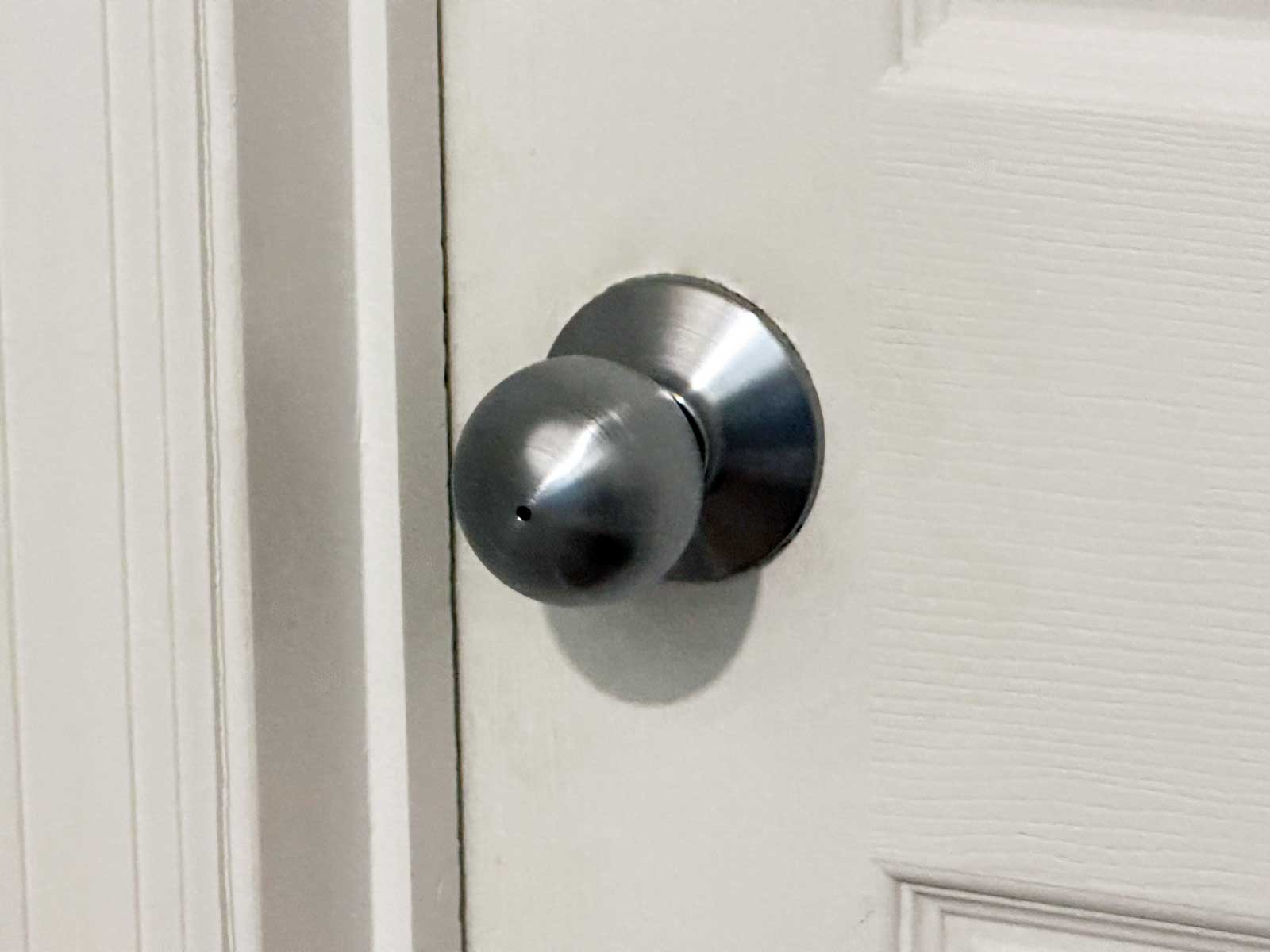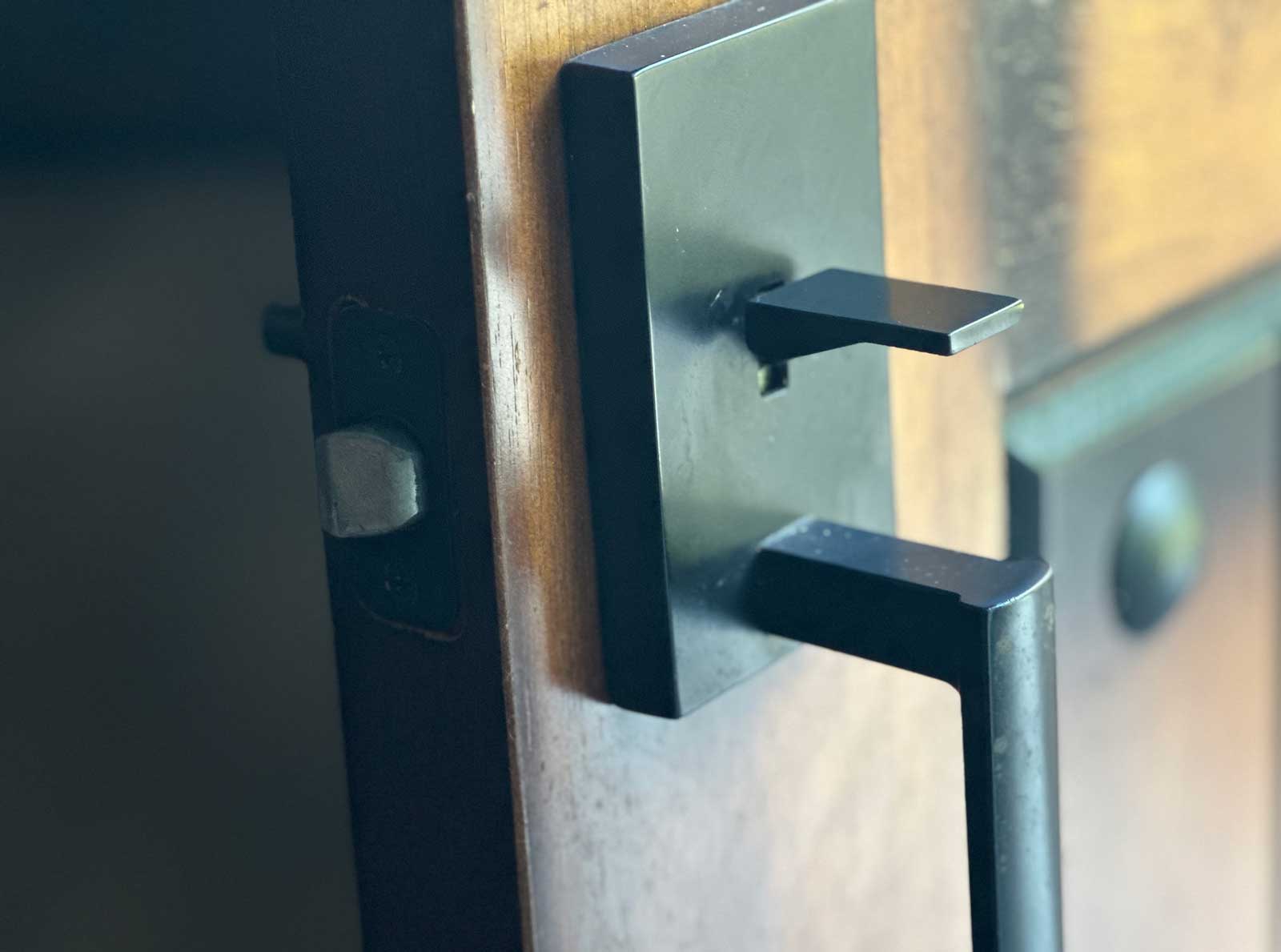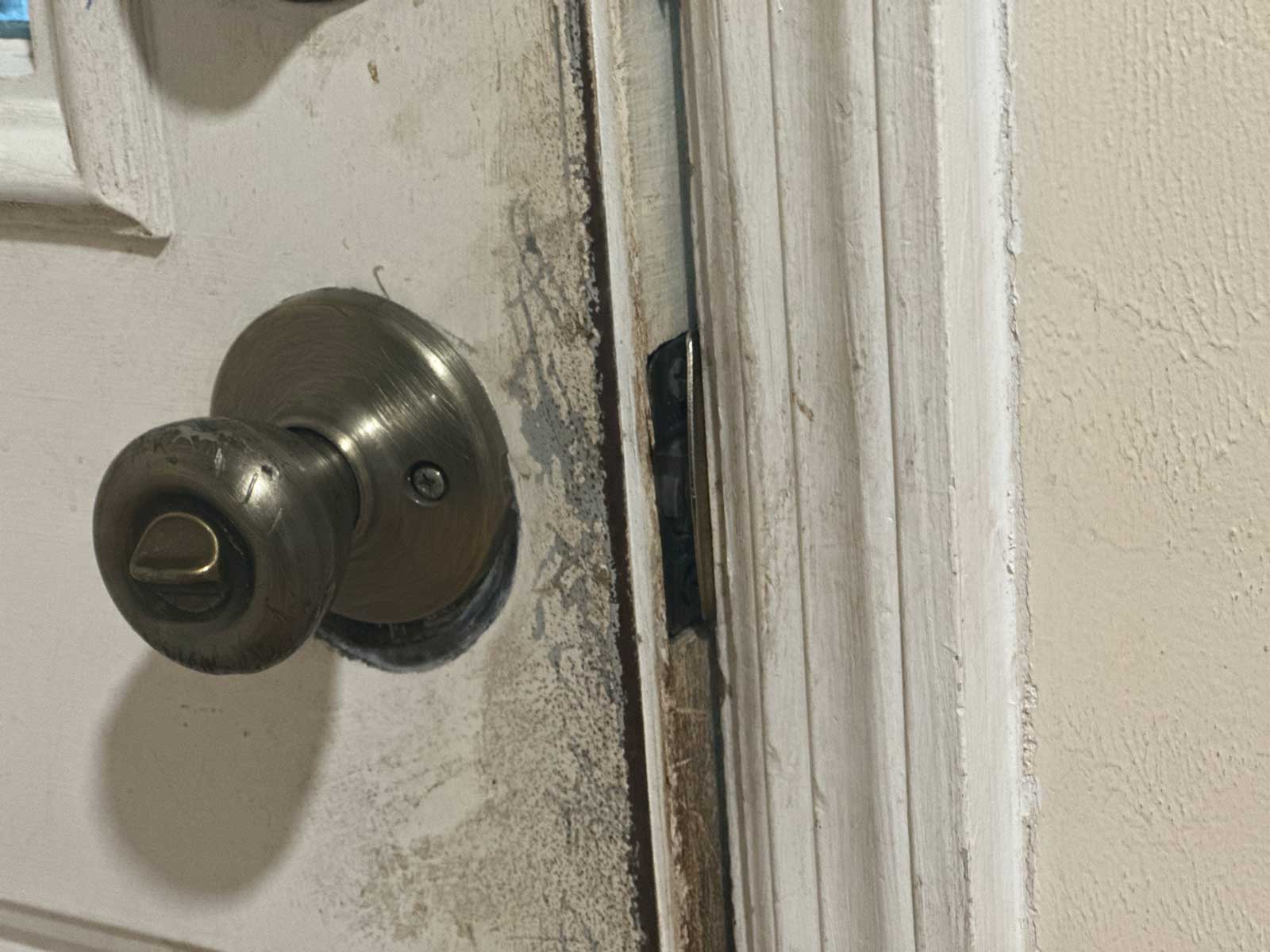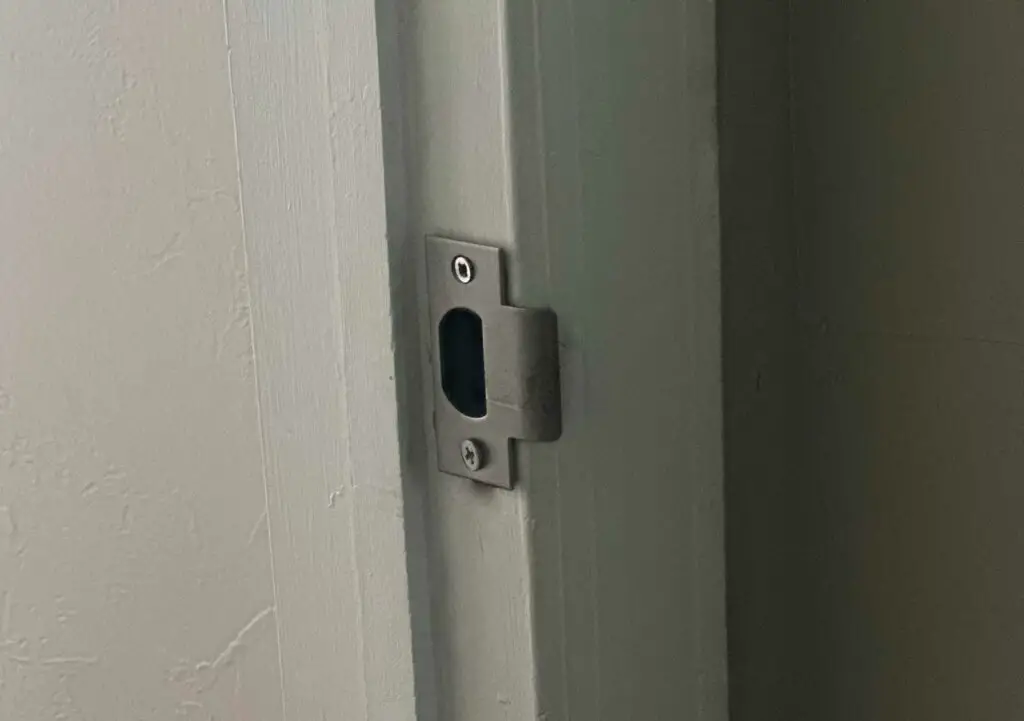Imagine coming home after a long day at work, and the last thing you want to deal with is a door latch that doesn’t reach the strike plate. It’s a small issue, but one that can make a world of difference when it comes to home security and peace of mind. Door latches are an essential part of our everyday lives, keeping our homes and belongings safe from potential break-ins and intruders. But what happens when that trusty door latch suddenly fails to meet the strike plate? Is it a simple fix, or are you in for a world of trouble? (Hint: It’s easier than you might think).
In this article, we’re going to dive into the common issue of a door latch that doesn’t quite reach the strike plate. We’ll explore the possible reasons behind this pesky problem and provide practical solutions to get your door back to its fully functional state. This isn’t just about convenience – a properly functioning door latch is essential for the security and safety of your home. So, let’s roll up our sleeves and tackle this latch issue together (don’t worry, no carpentry expertise is required).
To set the stage, picture this: I once found myself in a similar situation with my front door. The door latch simply refused to cooperate, and no amount of force or pleading could make it catch on the strike plate. After some research and a bit of elbow grease, my door is now working smoothly and securely. It was during those moments of frustration and troubleshooting that I realized how important it is to understand and maintain our door hardware. And now, I’m sharing that knowledge with you. Let’s get started!

Understanding Door Latch and Strike Plate
Ever had that annoying moment when your door latch doesn’t quite reach the strike plate? We’ve all been there. Thankfully, there are simple solutions to this common problem. In this section, we’ll delve into the nitty-gritty of door latches and strike plates, helping you understand why things go wrong and how to fix them. So, let’s dive right in!
Door latches are the essential components of a door lock system that keep your door securely closed. When you turn the door handle, the latch retracts and disengages from the strike plate, allowing the door to open. On the flip side, when the door closes, the latch extends and engages with the strike plate, keeping it closed and secure.
The strike plate is the stationary piece of metal attached to the door frame where the latch engages. It’s crucial for the proper functioning of the lock system and the overall security of your home. However, sometimes the alignment between the door latch and the strike plate may not be perfect, causing the latch to not reach the plate and thus, leading to a door that just won’t stay closed.
This misalignment can be caused by a variety of factors, such as door warping, settling of the house, or even just repeated use and wear. But fear not! Troubleshooting and fixing a latch that doesn’t reach the strike plate can often be done with just a few simple adjustments or modifications.
For example, one way of identifying the issue is by applying a marking substance like chalk, wet ink, or graphite from a pencil on the latch, then closing the door to see where it makes contact with the strike plate (DIY.stackexchange.com). This will help you understand whether the problem lies in the vertical or horizontal alignment.
Once you’ve identified the problem, it’s time for action! You may need to fine-tune the positioning of the strike plate by loosening the screws and slightly adjusting its position. Alternatively, you could file down the edges of the plate to ensure a smoother contact between the latch and the plate.
It’s essential that your doors work correctly, as they not only provide privacy and insulation but also play a crucial role in your home’s security. So, don’t let a misaligned door latch and strike plate ruin your day – or your home’s safety. With a little elbow grease (and one time when I fixed my neighbor’s door while they were on vacation, a dose of persistence), you can identify the issue and have your door working smoothly once again.
Remember, a properly functioning door is the key (pun unintended!) to a safe and secure home. Now go tackle that pesky latch and strike plate problem like a pro!

Common Problems with Door Latches
Has your door ever refused to latch, leaving you feeling unsecured and frustrated? Well, you’re not alone. Many homeowners face common problems with door latches, and there’s usually a straightforward solution. Let’s dive into the most frequent issues and their fixes.
Misaligned door latches often result in the latch not reaching the strike plate. This misalignment can be due to improper installation, settling, or warping of the door itself. To correct this, adjusting the strike plate might be necessary. Just like the Family Handyman recommends, you can file the edge of the strike plate until the latch clicks into place.
Stuck or jammed door latches can originate from rust or dirt buildup inside the latch mechanism. The culprit could be an uncleaned lock, leading to internal debris accumulation. Believe me, I’ve had my fair share of creaky, stubborn door locks at my old apartment. A quick solution to this issue is applying a lubricant specifically designed for locks, such as graphite or silicone spray. This will ensure smooth operation and prevent further complications.
Sometimes, door latches can also get frozen, especially during winter. The low temperatures cause the metal to contract, making it harder to turn the lock. A simple trick to thaw it out? Use a hairdryer! Heat the latch gently for a few minutes and try unlocking the door again. If it still doesn’t work, consider calling a professional locksmith to avoid causing more damage to the lock.
Catching and sagging doors might also result in latching issues. A sagging door is often caused by loose or worn hinge screws. Tightening or replacing these screws should bring the door back to its proper position and prevent the latch from catching. Additionally, adding a thin cardboard shim behind the hinge leaf can help align the door and resolve the problem.
Time to bust out the toolbox and get your door back in working order! Remember, it’s crucial to address these common problems with door latches promptly. Not only do they ensure your safety and security, but they also make your entrance as smooth and hassle-free as possible – just like it should be. So, let’s get that door latch fixed and leave those frustrations behind!

Signs and Identification of Misalignment
Door latches and strike plates are essential components that need to be aligned correctly to ensure smooth functioning and security. But what happens when your door latch doesn’t reach the strike plate? Worry not! Here’s how to identify this issue using some handy tips and tricks.
- The Lipstick Test: A quick and easy way to check for misalignment is by conducting the lipstick test. Apply lipstick, chalk, ink, or wet paint to the latch, close the door, and let the latch release into the strike plate area. The marks left behind will show you exactly where the problem lies.
- Rubbing: Another sign of misalignment is rubbing on the door frame or jamb. If you notice wear or scuff marks, it could be an indicator that your latch and strike plate are not properly aligned.
- Hinges: Misaligned or sagging hinges can also cause your door latch to not reach the strike plate. Check their position on both the door and the frame – if they are out of place, they may be causing the problem. (Pro tip: As a homeowner, I once tackled a misaligned hinge using a simple screwdriver. Trust me, it’s not rocket science!)
- Using a Square: A tried and true method for identifying alignment issues is by using a square. Place the square against the closed door near the latch and strike plate – if there’s a gap, you’ve got yourself an alignment problem.
Once you have identified the issue, addressing it becomes much easier. A simple adjustment, realignment, or even greasing the hinges can often solve the problem. Remember, it’s crucial to get this resolved as soon as possible, as misaligned door components not only hinder smooth operation but also pose security risks.
In conclusion, identifying signs of misalignment might save you a trip to the hardware store (and protect those precious home assets). Whichever method you use, ensure accuracy and watch out for those sneaky door latch misalignments!

Tools and Materials for Fixing
You’re probably standing in front of your door, frustrated that the latch just won’t reach the strike plate. Fear not: with a few simple tools and materials, you’ll have that door shutting smoothly in no time. As you’re about to discover, the process to fix this issue doesn’t require an engineering degree and can be accomplished in a jiffy. (You know, like the time it took to learn the names of all the Avengers.)
Screwdriver and some extra screws are essential. You don’t know what you’ll find behind that plate, and it’s better to be prepared for any surprises. In addition, a hammer and wood chisel will come in handy for adjusting the strike plate hole, ensuring that perfect latch-to-strike-plate alignment.
A file is crucial for smoothing and reshaping the strike plate or the hole itself. Like sandpaper on a skateboard ramp, a file removes the rough edges and helps your latch glide effortlessly into the strike plate.
Your friend in this journey will be wood filler, for patching up any gouges or imperfections during the adjustment process. After all, aesthetic appeal matters too when it comes to home repairs. Make sure to have some paint or stain on hand to match your door frame, as a seamless finish is always the cherry on top of a successful project.
Sometimes, the latch problem may be due to an alignment issue. Here, shims are the unsung heroes that rectify door frame imperfections, propping them up like a useful little sidekick.
Last but not least, a trusty vise or clamp will assist in holding the strike plate securely while you file or chisel any necessary adjustments. As my grandpa used to say, “A firm grip makes for a steady hand!” (He wasn’t talking about door repairs, but it’s still relevant.)
And there you have it: a list of essential tools and materials to help you tackle that pesky door latch problem. With these items at your side, you’ll be well-equipped to conquer the challenge ahead. Now go on, channel your inner handyman, and show that door who’s boss!
Tips to Fix Misaligned Latch and Strike Plate
You could be dealing with a nightmare situation: the door latch doesn’t reach the strike plate, leaving you with a stubbornly non-closing door. Fear not, we have some quick and easy tips to solve this issue.
First, adjust the strike plate by loosening the screws and shifting it in the direction needed for the latch to catch (source). You may need to move the strike plate by creating new holes if the misalignment is significant. Keep in mind, doors and homes can settle over time, causing these pesky misalignments.
If that doesn’t work, consider tightening any loose hinges. Using a screwdriver, tighten the hinges to ensure the door is held firmly in place. This simple adjustment can often realign the latch and strike plate, making your door functional again.
Another handy trick is to shim the hinge by inserting thin pieces of cardboard or other material behind the hinge. This can help raise or lower a door to position the latch and strike plate correctly. Remember: a small shift can make a big difference.
Still stuck? Don’t worry, we’ve got a personal anecdote that might just save the day. A friend’s door latch had severe rust and was unable to reach the strike plate. The solution was simple: remove the rust using a wire brush and lubricate the latch mechanism. It was as good as new in no time!
For those who are more DIY-savvy, another option is to grab a drill and enlarge the hole in the strike plate. This can be done with a rotary tool or even a small file (source). But be cautious and patient, as removing too much material can cause the strike plate to lose its structural integrity.
Lastly, you can use the age-old trick of chalk to find the misalignment. Rub chalk on the latch and gently close the door. Where the chalk transfers to the strike plate will indicate the precise point of misalignment. This can then guide your adjustment methods.
With these practical tips and a little elbow grease, you’ll have your door latch and strike plate in perfect alignment, letting you regain peace of mind (and a properly closing door!).
Dealing with Hinge Problems
Have you ever faced that annoying situation where your door latch just doesn’t reach the strike plate? Worry not, the solution might be simpler than you think! Let’s dive into some hinge-related issues and get that door functioning properly again—fast! (No more letting the cold drafts in, am I right?)
First things first, let’s talk about loose hinges. If your door isn’t latching properly, it may be because the hinges are slightly loose. So, grab your screwdriver and make sure the screws holding the hinges in place are tightened. Sometimes, all it takes is a quick turn or two to bring those misaligned hinges back in sync.
Now, if tightening the screws doesn’t resolve the problem, you may be facing a subtle villain that not many people are aware of—sagging hinges. Fear not, though! A simple trick using a shim is sure to help you out. Just like the time I fixed that backyard gate before my big BBQ party (trust me, my guests appreciated the quick fix!).
To deal with sagging hinges, take out the screws of the affected hinge and slide a thin piece of cardboard, metal or plastic behind it. This will effectively “shim” the hinge and bring it back to its original position. Reinstall the screws and voilà! Your door latch should now reach the strike plate effortlessly.
But wait, there’s more! If your door is still giving you trouble, it could be due to a hinge that’s ever so slightly out of place. In this case, you’ll want to try a less-known, yet fool-proof technique: swapping out the shorter hinge screws for longer ones. Use 3-inch screws that will grab onto the wall framing and pull the entire doorjamb slightly inward.
And there you have it! With these simple tips and tricks, those hinge problems should be history. No more fumbling with the door, and no more frustrations. Just smooth, sweet, (and most importantly) properly functioning doors. So go on, reclaim your peace of mind and enjoy the satisfaction of a well-latched door.
Adjusting Strike Plate Hole
You’ve been there, right? Your door latch just won’t reach the strike plate, and you’re left with an annoying creaky door. Don’t worry! You’re not alone – and fixing this nuisance is easier than you might think. Grab your trusty file, drill, and follow these simple steps.
Step 1: Examine the strike plate hole. Take a look at the strike plate hole to see if it’s too narrow or misaligned. If needed, you can file off enough metal to widen the hole and accommodate the latch. Remember, filing too much could lead to a loose, rattling door, so take it slow and steady.
(As a homeowner myself, I’ve faced this issue and learned that patience is key during adjustments.)
Step 2: Remove the strike plate. If your strike plate isn’t sitting flush with the door frame, it’s time to reposition it. Simply remove the screws and set the plate aside. You’ll need your drill handy for the next step.
Step 3: Adjust the screw holes. Using your drill, create new screw holes slightly above or below the original ones, depending on the direction you need the strike plate to move. Be cautious when drilling the new holes – one small slip could lead to more unnecessary headache.
Step 4: Reattach the strike plate. With the new screw holes ready, fasten the strike plate back into place. Close the door and test the latch to ensure it smoothly catches inside the plate. Viola! Your door is as good as new!
And there you have it: a quick fix to a pesky door problem that had you feeling unhinged. You’re welcome!
Installing New Lock and Strike Plate
Have you ever experienced that annoying door latch that just doesn’t reach the strike plate? It’s time to put your worries aside and dive into some DIY. Say goodbye to that pesky problem by installing a new lock and strike plate. Let’s get started! (My neighbor Tom did this last weekend, and now he’s the hero of his household).
First things first, gather your tools: a new lock, strike plate, screws, hammer, drill, wood filler, and paint. Having everything at arm’s reach will make the process smoother.
Prepare for the installation by removing the old lock and strike plate from the door. Fill any existing screw holes with wood filler and let it dry completely. Nowadays, wood filler dries pretty fast (unlike my favorite condiment, ketchup! But that’s a different story).
With the area ready, grab your drill. Carefully measure and mark the spots where you’ll need new holes for the lock and strike plate. Be precise – a small mistake can result in an ill-fitting plate, taking us back to the original problem.
Once the markings are set, drill the new holes. Drilling may seem intimidating, but remember you’ve got this! (Think of it as the ultimate test of your handyman prowess).
Position the new strike plate on the door frame and align it with the freshly drilled holes. Secure it with the provided screws. It’s starting to look good, isn’t it?
Now it’s time to install the new lock on the door. Slide it in and align it with the corresponding hole in the strike plate. Once it’s in place, fasten it with the appropriate screws.
Finally, give the door a makeover with a fresh coat of paint, making it look as good as new (and maybe even impressing the mother-in-law).
And there you have it! With your newfound skills, you’ve not only fixed the door latch issue but also elevated your DIY cred. The next time a door dares not to latch, you’ll be ready to tackle it head-on (just like you would any other life challenge).
Preventive Measures and Maintenance Tips
Does your door latch have trouble reaching the strike plate? Fear not, my friend! With a few simple preventive measures and maintenance tips, your door will be as good as new in no time. Let’s dive in, shall we? (No safety goggles required!)
First things first, keep an eye on the paint job on your door and its frame. A fresh coat of paint can sometimes cause the latch to stick or not reach the strike plate. To avoid this, make sure to sand down any excess paint, especially around the strike plate area. This small DIY project can make a huge difference in the smooth operation of your door.
Now, let’s talk about weatherstripping. This may seem unrelated, but it can actually affect the alignment of your door with the strike plate. If your weatherstripping is damaged or poorly installed, it can prevent your door from closing properly. Take a few minutes to inspect and replace it, if necessary. Trust me, your door (and your energy bill) will thank you later!
Dealing with moisture issues? They could be causing your door latch to miss the strike plate. Moisture can lead to swelling of the door and the frame, making it harder for the latch to reach its destination. Keep your doors dry and address any pesky moisture-related issues promptly.
When it comes to adjustments, a little DIY spirit can go a long way. If your door latch is just slightly off, consider using a file to carefully remove some material from the strike plate, as shown in The Family Handyman’s guide. This can help create enough space for the latch to catch and secure the door.
Sometimes, all your door needs is a little TLC. Make sure to periodically tighten all the screws on the hinges and strike plate. If the strike plate is loose, your latch may not align properly, resulting in the dreaded door-that-won’t-close scenario. Just grab a screwdriver (or your trusty power drill) and give those screws a good tightening!
Finally, if your door is looking worse for wear, consider giving it a new stain or finish. A well-maintained door is not only more pleasing to the eye but also less likely to cause issues down the line, like latch and strike plate misalignment.
Take it from me (and my countless door-fixing adventures over the years), following these preventive measures and maintenance tips can help you avoid becoming that guy with the door that won’t latch. And nobody wants to be that guy, am I right? Give your door some love, and it’ll love you back by closing properly every single time. You got this!






